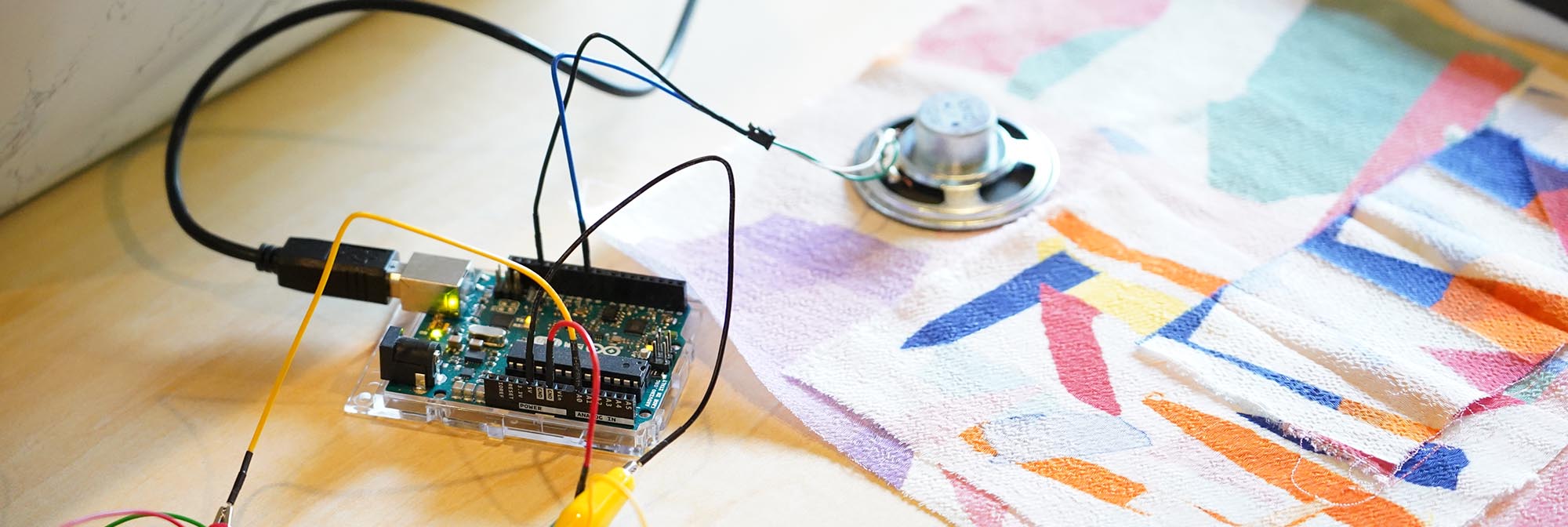This summer, for the second year running, selected staff and students from Chelsea College of Arts’s Textile Design courses took part in a research trip to the Kyoto Institute of Technology (KIT), based in the ancient and beautiful city of Kyoto in Japan.
Alongside designers and design researchers from around the world, BA Textile Design student Roberta Schreyer and Lisa Bloomer a Senior Lecturer on BA Textile Design, took part in the KYOTO Design Lab Textile Summer School, whose mission is to reimagine uses for the traditional ‘chirimen’ kimono silk for a contemporary context and explore the possibilities of embedding technology in textile surfaces.

, Chelsea College of Arts, UAL | Photograph: Roberta Schreyer
Led by Professor Julia Cassim who joined KYOTO D-Lab at its inception in 2014, the textile summer school participants have access to KYOTO D-Lab's specialist workshops which encourage cross-fertilisation of materials and process, knowledge exchange and expertise, where textile engineers and material scientists meet designers meet coders to untangle ‘universal design’ problems and co-discover creative solutions to these.
“Since 2015, KYOTO Design Lab has been working with KyoTango weavers on a series of projects whose aim has been to use design as an active means to revitalise the chirimen industry in KyoTango” explained Julia.
“This has been done in a variety of ways: by re-engineering chirimen using sustainable bio-plastics so that it can embrace new product scenarios for Japan’s burgeoning healthcare markets and through the annual Textiles Summer School now in its third year, which is held in collaboration with the RCA, UAL, the Design Academy Eindhoven, ArtEz, Kyoto Saga University of the Arts and KyoTango City."
Caryn Simonson, Programme Director for Textile Design and knowledge exchange ‘champion’ in the Camberwell, Chelsea and Wimbledon Design School gave an overview of the trip:
“The summer school’s aims highlight the benefits of collaboration, interdisciplinarity and meaningful ‘knowledge exchange’ between education, research, local communities and business. It has benefitted staff and students to take precious time to enrich their practice and share ideas, engage in making and explore new applications for textiles through social design approaches in a global design context.”

, Chelsea College of Arts, UAL | Photograph: Roberta Schreyer
Roberta Schreyer, now in her final year on BA Textile Design, was fully funded by UAL to partake in the summer programme at KIT following a successful application.
Her week at the summer school comprised workshops and presentations where the participants were able to collaborate with each other: “All the projects in Kyoto where a collaboration. We switched teams, always mixing pathways, backgrounds, working together with students, teachers, and other professionals.”
Roberta also got to work with the weavers of KyoTango to come up with alternative uses for their textiles other than traditional kimono. This included experimenting with the properties of ‘smart yarns’. Roberta and Lisa both participated in workshops introducing them to Arduino, run by Berlin-based designer and artist Mika Satomi, one of the founders the collective KOBAKANT and whose work explores the field of eTextiles. Roberta explained: “I worked with conductive yarns, combining them with non-conductive yarns to make a collection of smart yarns. These could be woven or knitted into a textile and in my group we also developed them into sensors that triggered sound when activated.”
For the final project, Roberta collaborated with a weaving teacher and a UX designer. “It was challenging at times as we had such different backgrounds” she says, “but we could learn a lot from each other, since we all came from different pathways and brought different experiences and cultures to the table.”

, Chelsea College of Arts, UAL | Photograph: Roberta Schreyer
“The main thing I took from my experience is how important collaboration is. It was incredible to work together with other creatives and see how quickly you could bounce ideas off one another and come up with concepts. I really enjoyed that! I came away with friends that will influence me in my future career.”
As one of the youngest participants, Roberta found it interesting to compare how far her practice had developed compared to other students, too. “It was really motivated me to continue working ambitiously during my final year here at Chelsea. I was interested in the future of textiles before, and the programme sparked my interest in smart textiles even more - I definitely want to continue working with them.”

, Chelsea College of Arts, UAL | Photograph: Roberta Schreyer
Since the summer, Chelsea was delighted to welcome Julia Cassim to the college for a talk in the autumn term which attracted students from across the design courses.
Starting by building a design scenario through seemingly disconnected potential users, she demonstrated how common connections between three potential users can generate new ways of thinking. The students were invited to consider how an inclusive design approach allied to materials experimentation and digital fabrication can generate new approaches to design “as it relates to textiles as surface, material, scenario and product”.
As well as introducing the KIT Design Lab Textile Summer School’s work with ‘chirimen’ kimono silk, Julia presented inclusive design projects she has worked on in Eastern Europe with local communities and a project using waste husks from palm oil industry to create a new material for products.

Reflecting on her experiences in Japan, Roberta was keen to state the value of working alongside peers from all over the world: “I found it incredibly enriching working with professionals on their fabrics and using my own knowledge to help them. It really made me understand more about working in a professional environment together with other creatives. Overall my trip to Kyoto was one of the best things that have ever happened to me. I cannot wait to go back one day to discover more!”
Explore Chelsea’s BA Textile Design
Find out more about Kyoto Institute of Technology's KYOTO Design Lab Textiles Summer School

